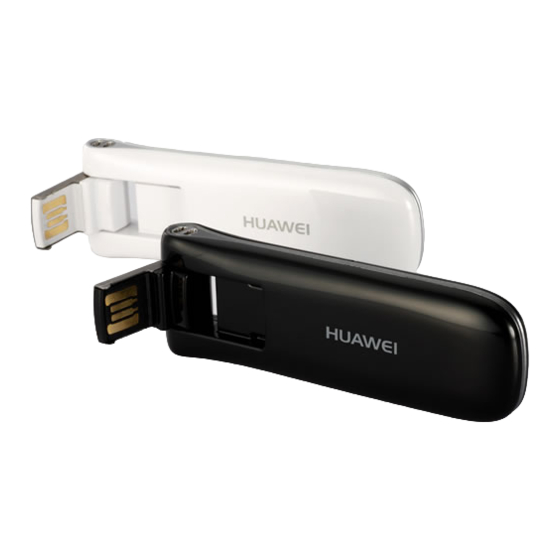
Huawei E180 Manual
Mobile broadband e180 hspa rotate usb stick
Hide thumbs
Also See for E180:
- Quick start manual (20 pages) ,
- User manual (24 pages) ,
- Quick manual (29 pages)
Table of Contents
Advertisement
Copyright © 2008 Huawei Technologies Co., Ltd.
All Rights Reserved
No part of this document may be reproduced or transmitted in any form or by any means without
prior written consent of Huawei Technologies Co., Ltd.
Trademarks and Permissions
and other Huawei trademarks are trademarks of Huawei Technologies Co., Ltd.
All other trademarks and trade names mentioned in this document are the property of their
respective holders.
Notice
The information in this document is subject to change without notice. Every effort has been made in
the preparation of this document to ensure accuracy of the contents, but all statements,
information, and recommendations in this document do not constitute the warranty of any kind,
express or implied.
Advertisement
Table of Contents

Summary of Contents for Huawei E180
- Page 1 No part of this document may be reproduced or transmitted in any form or by any means without prior written consent of Huawei Technologies Co., Ltd. Trademarks and Permissions and other Huawei trademarks are trademarks of Huawei Technologies Co., Ltd. All other trademarks and trade names mentioned in this document are the property of their respective holders.
-
Page 2: Table Of Contents
Table of Contents Getting to Know the E180....................1 Requirements for the PC..................... 3 Preparing the E180......................4 Installation Guide ....................... 5 Safety Information......................8... -
Page 3: Getting To Know The E180
Note: This manual briefly the preparation, the process for installing/uninstalling, and safety precautions for using Huawei E180 HSPA Rotate USB Stick (hereinafter referred to as the E180). You are recommended to read the manual before using the E180. Getting to Know the E180... - Page 4 Micro SD card slot Holds the Micro SD card. USIM/SIM card slot Holds the USIM/SIM card. Rotatable USB connector Connects to the USB interface of the PC.
-
Page 5: Requirements For The Pc
Indicates the status of the E180. Green, blinking twice every 3s: The E180 is powered on. Green, blinking once every 3s: The E180 is registered to the GSM/GPRS/EDGE network. Blue, blinking once every 3s: The E180 is registered to the WCDMA/HSDPA/HSUPA network. -
Page 6: Preparing The E180
Preparing the E180 Take out of the back cover of the E180. Insert the USIM/SIM card and the micro SD card into the card slots. Make sure that the card is properly inserted. Note: Micro SD card is an optional accessory. If the micro SD card is not provided in the package, you can buy one yourself. -
Page 7: Installation Guide
PC. The following section takes Windows XP as an example. Connecting the E180 with a PC Note: Power on your PC before connecting the E180 with the PC. Otherwise, the normal installation of the E180 may be affected. - Page 8 The other way: connect the E180 to a PC using the USB extension cable. Installing the E180 Management Program Connect the E180 with the PC. The OS automatically detects and recognizes new hardware and starts the installation wizard. Note: If the auto-run program does not respond, find the AutoRun.exe file in the driver path. Then...
-
Page 9: Removing The E
Launching the Management Program After the E180 is installed, the management program is launched automatically. Then every time the E180 is connected to the PC, the management program is launched automatically. You can also double-click the shortcut icon on the desktop to launch the management program. -
Page 10: Safety Information
Safety Information Read the safety information carefully to ensure the correct and safe use of your wireless device. Interference Do not use your wireless device if using the device is prohibited or when it causes danger or it interferes with electric devices. Medical Device Do not use your wireless device and follow the rules and regulations set forth by the hospitals and health care facilities. -
Page 11: Weee Approval
Area indicated with the "Power off bi-direction wireless equipment" sign Area where you are generally suggested to stop the engine of a vehicle Traffic Security Observe local laws and regulations while using the wireless device. To prevent accidents, do not use your wireless device while driving. RF signals may affect electronic systems of motor vehicles. -
Page 12: Rohs Approval
RoHS Approval The wireless device is in compliance with the restriction of the use of certain hazardous substances in electrical and electronic equipment Directive 2002/95/EC (RoHS Directive). Laws and Regulations Observance Observe laws and regulations when using your wireless device. Respect the privacy and legal rights of the others. -
Page 13: Body Worn Operation
Specific Absorption Rate (SAR) Your wireless device is a radio transmitter and receiver. It is designed not to exceed the limits for exposure to radio waves recommended by international guidelines. These guidelines were developed by the independent scientific organization ICNIRP and include safety margins designed to assure the protection of all persons, regardless of age and health. - Page 14 FCC Statement This device complies with Part 15 of the FCC Rules. Operation is subject to the following two conditions: (1) this device may not cause harmful interference, and (2) this device must accept any interference received, including interference that may cause undesired operation. * This device should be installed and operated with a minimum distance of 20 cm between the radiator and your body when using it via USB cable.






Need help?
Do you have a question about the E180 and is the answer not in the manual?
Questions and answers